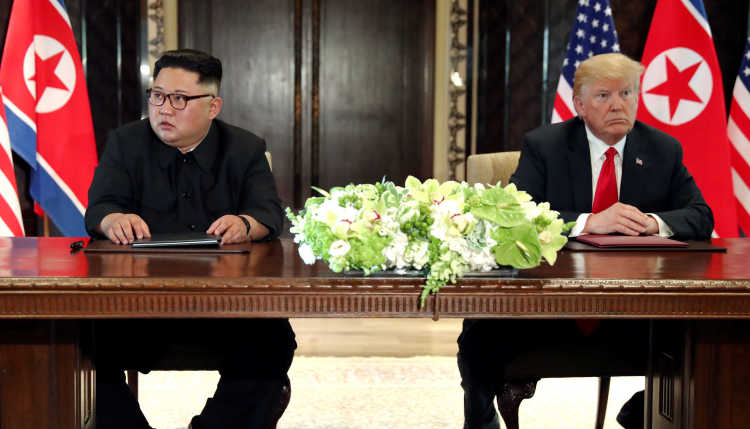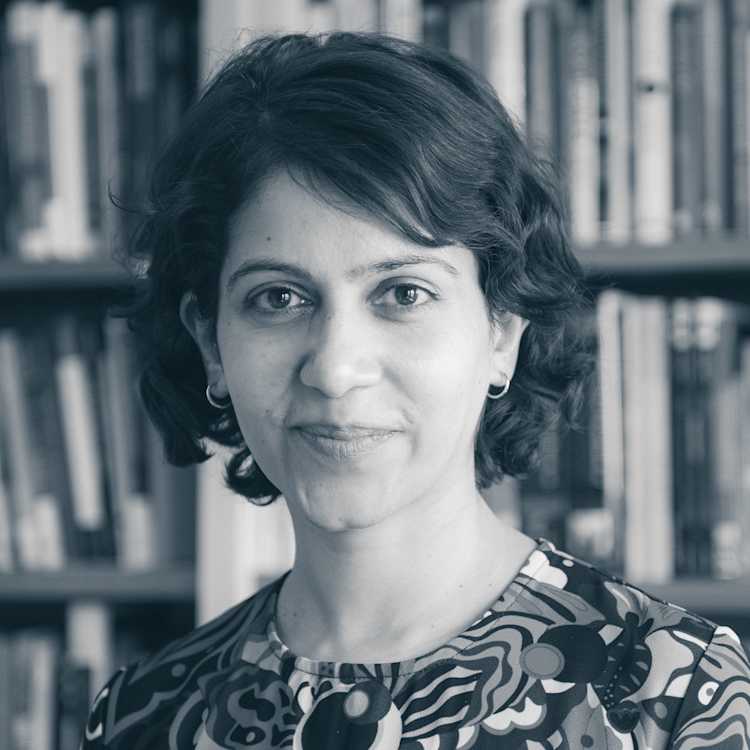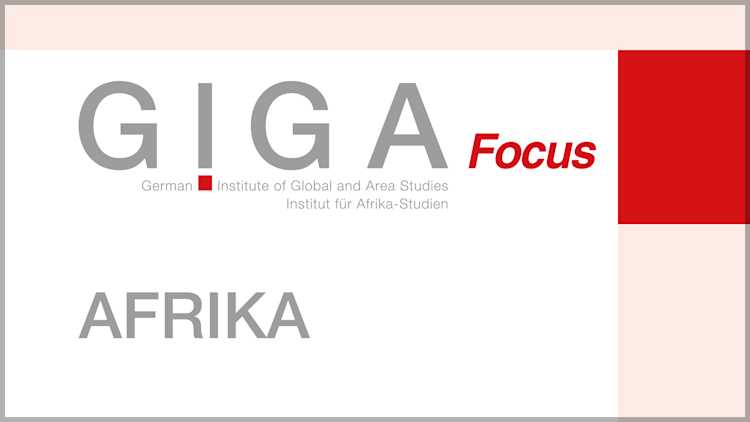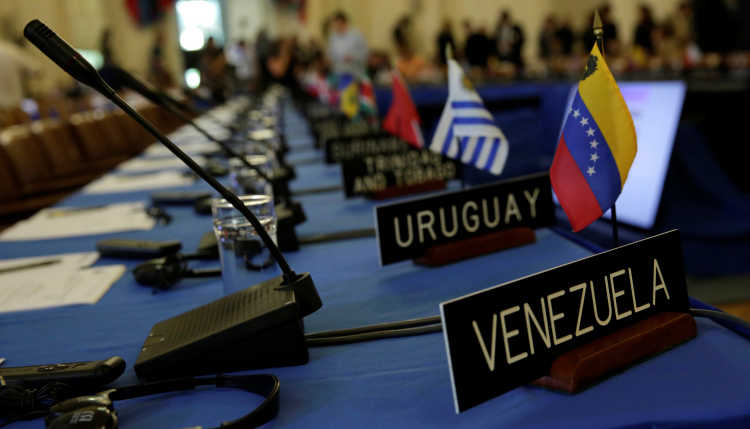- Home
- Publications
- GIGA Focus
- The Denuclearisation of North Korea: From Maximum Demands to Arms Control
GIGA Focus Asia
The Denuclearisation of North Korea: From Maximum Demands to Arms Control
Number 2 | 2019 | ISSN: 1862-359X

During its 2019/2020 term as a member of the UN Security Council, Germany aims to generate impetus for disarmament and arms control. A particular challenge in this regard is presented by North Korea’s development of its nuclear and missile arsenals. In 2017, Kim Jong Un and Donald Trump escalated the conflict surrounding this issue. Then in 2018, summit meetings between Washington and Pyongyang and between the two Koreas opened up the possibility of future cooperation. However, the US and North Korean positions on denuclearisation remain far apart.
The summits in 2018 led to a decrease in tensions. Diplomacy, rather than the threatening gestures of 2017, was the focus. This was a significant step forward.
North Korea halted its nuclear and missile tests, and the USA suspended its military exercises with South Korea. However, North Korea does not want to comply with the demand for rapid and complete denuclearisation.
Without substantial advances regarding the nuclear question, the sanctions on North Korea will remain in place. The opportunities for inter-Korean cooperation will also remain limited.
The summit agreement between Kim and Trump from June 2018 and the second summit planned for the end of February 2019 offer a chance to achieve normal bilateral relations, a peace regime on the Korean Peninsula, and the curbing of the nuclear threat in the medium term.
It would now make sense to agree on clear interim steps related to stopping the production of nuclear fissile material and its use in weapons technology, and the dismantling of the North Korean missile arsenal. In return, suitable corresponding steps should be offered.
Policy Implications
The complete dismantling of North Korea’s nuclear arsenal should remain the goal, but is unrealistic in the short term. The German government should use its seat on the UN Security Council to push for pragmatic interim steps, as these offer the best chance of increasing security in Korea and the region. In line with German priorities, the focus should now be on effective disarmament and arms-control measures.
The Escalation and De-Escalation of the North Korea Conflict
After Kim Jong Un took power at the end of 2011, North Korea massively expanded its missile testing. In 2017 it also tested three long-range intercontinental ballistic missiles (ICBMs). The latter increased the direct threat to the United States – and Europe. This was accompanied by intensified nuclear weapons tests, which culminated in the testing of a hydrogen bomb in 2017. These events confirmed the warnings of departing US president Obama to his successor, Donald Trump, that North Korea’s nuclear and missile programme represented the most dangerous threat to the USA.
In 2017, Kim and Trump systematically escalated the conflict regarding North Korea’s nuclear and missile arsenal. Threats and insults were exchanged. Trump stressed that because of North Korea’s provocations, all options, including military ones, would be considered. In August 2017 he threatened Kim with “fire and fury like the world has never seen.” North Korea responded by threatening to fire missiles at the US military base in Guam. This did not, however, take place; North Korea appears to have shied away from further escalating the spiral of conflict given the threats coming from Washington. While the leadership in Pyongyang had consciously presented itself as unpredictable in the past, it was now confronted with the same unpredictability – feigned or not – on Washington’s side. Based on this new dynamic, an armed conflict no longer appeared impossible. South Korea, which would be among the main victims of such a conflict, was able only to watch the dangerous spectacle from the sidelines.
For this reason, South Korean president Moon Jae-in gladly took up a diplomatic offer made by Kim at the beginning of 2018. The crisis year 2017 was followed in 2018 by the year of summit diplomacy. This Focus first examines what was and was not achieved via this summit diplomacy. It then addresses how to move forward – taking the second summit between Trump and Kim into account. It recommends a process that entails concrete disarmament and arms-control measures in return for steps in the direction of diplomatic relations between the USA and North Korea, for a peace regime, and ultimately for the complete denuclearisation of the Korean Peninsula.
What Was and Was Not Achieved in 2018
In his 2018 New Year’s address, Kim Jong Un explained that North Korea had “perfected” its nuclear forces. It thus possessed a “powerful deterrent” against the USA and could now proceed to the mass production of nuclear warheads and missiles. At the same time, he offered his country’s participation in the Winter Olympics in South Korean Pyeongchang and called for the reduction of military tensions and the improvement of relations. This overture was immediately taken up by the government in Seoul. The subsequent working meetings led to an extremely dense course of summit diplomacy regarding the Korean Peninsula which included no fewer than three summit meetings between the leaders of the two Koreas. There had previously only ever been two summit meetings, in 2000 and 2007. In addition, Kim travelled to China for the first time in March 2018 to confer with President Xi Jinping; three further summits followed in the period up to January 2019. However, the indisputable highlight of “summit year” 2018 was the first meeting between the political leaders of the USA and North Korea, which brought Trump and Kim together in Singapore on 12 June 2018.
As Richard Feinberg and Stephen Haggard (2018) argue, “summitry” could gain in importance in view of the Trump government’s questioning of multilateral institutions. Summit meetings are not (only) about negotiations and agreements, but can also fulfil other functions: networks can be developed; particular norms and values can be strengthened; the degree of room to manoeuvre can be tested; initiatives can be started; and last but not least, signals of political leadership that are also intended for a domestic audience can be transmitted. The increased density of many summit meetings also means it can no longer be assumed that all such meetings are prepared well in advance and result in carefully formulated agreements.
For example, the numerous summits regarding the Korean Peninsula in 2018 also served, not least, to create the appropriate mood between the participants or to maintain momentum. Accordingly, summit meetings do not always have to be the end result of lengthy low-level negotiations but can also initiate or facilitate them. The 2018 summit with Kim Jong Un was also a litmus test for Trump’s highly personalised, ad hoc, and transaction-oriented approach to diplomacy. For Trump it was ultimately about understanding how Kim “ticks” and whether a “deal” is possible.
What were the key outcomes of summit year 2018, and above all the Trump-Kim summit? Even before the first summit meeting with Moon, Kim announced that in view of the successes achieved to date, all testing of nuclear weapons and ICBMs would be halted and the nuclear test site Pyunggye-ri, where all previous tests had taken place, would be shut down. The tunnels were in fact exploded (which also made a detailed assessment of North Korea’s atomic testing activities significantly more difficult) in May 2018, in front of the assembled press; experts were not present. For his part, Trump announced directly after the summit meeting with Kim that he would put the “very expensive” and “very provocative” joint military exercises with South Korea, which take place each year in various forms, on hold for the duration of the talks with North Korea. To date, both sides have maintained these promises. In effect, this meant the de facto application of the “Freeze for Freeze” proposal (a moratorium on nuclear and ICBM tests in exchange for the suspension of military exercises) brought forward by China and Russia but still firmly rejected by the US government in spring 2018 (Klingner 2018: 7).
The Results of the Singapore Summit
The actual, brief, and in places vague statement published after the summit in Singapore covered four points. Both sides agreed, first, to reconfigure their bilateral relations and, second, to “join their efforts to build a lasting and stable peace regime on the Korean Peninsula.” North Korea committed, third, to work towards the “complete denuclearization of the Korean Peninsula” (BBC 2018). And fourth, both sides committed to recovering the remains of US soldiers killed or missing in action in the Korean War (1950–1953) and to the immediate repatriation of those already identified (BBC 2018).
For Kim even the summit meeting itself – where he was on equal footing with the US president – was already a major success, which could be used to obtain legitimacy in the eyes of his own population. But Trump was also clearly interested in the summit in order to present himself as a problem solver. Following the summit he declared grandiosely that the nuclear threat from North Korea no longer existed and that complete denuclearisation was already underway. In the USA and Europe, however, the outcome of the summit was received with disappointment, or at least very cautiously. The final declaration did not go beyond the agreements made in the past, and partly fell short of them. It remained unclear how things would proceed in concrete terms. The demand for the “complete, verifiable, and irreversible denuclearisation” of North Korea, which had in previous years been repeated in mantra-like fashion by the USA – and had been incorporated in UN resolutions – was also not reflected in the statement. Following the summit, US foreign minister Pompeo spoke of a “final, fully verified denuclearization” (Klingner 2018: 12); this term was not more specifically defined, but suggested a certain flexibility.
Despite its brevity, a number of things about the declaration from Singapore are remarkable. First, the question of denuclearisation was connected to the improvement of bilateral relations and the creation of a permanent peace regime on the Korean Peninsula, and can thus no longer be addressed independently. It is also noteworthy that the order of the first three points more strongly reflects North Korea’s priorities. The reconfiguration of bilateral relations comes first, then the peace regime, and only in third place the issue of denuclearisation. That the discussion here refers to the denuclearisation of the “Korean Peninsula” and not of “North Korea” also reflects a long-standing North Korean position. Finally, the fourth point appears to be a tribute by Trump to veterans’ and surviving relatives’ associations in the USA. In fact, the recovery and repatriation of remains already took place between 1996 and 2005 (Haggard 2018).
Ultimately, neither side was able to achieve its main goal in Singapore; no concrete measures towards rapid denuclearisation were agreed, and no sanctions were lifted. What actually happened is that “the can just got kicked a bit further down the road,” as they say in the USA. Although a real breakthrough most certainly looks different, it can be said that the summit has launched a new process of dialogue and negotiation. Singapore will remain an important point of reference, and Trump risked a great deal with this unconventional summit, which his critics view as having valorised the North Korean regime. Whether the summit will one day be viewed as the starting point for a genuine transformation of the conflict on the Korean Peninsula or as the beginning of the dissolution of the US-centred security architecture in Northeast Asia remains to be seen.
Inter-Korean Summit Diplomacy
In any case, one positive development that resulted from events in 2018 is that South Korea can again play an active role in processes dealing with North Korea and is no longer condemned to an observer role. At the three inter-Korean summit meetings in 2018, steps were made to reduce tensions and build trust. In addition, the two Koreas laid the foundations for the resumption and development of economic and infrastructure cooperation. For example, a joint military commission with permanent communication channels was created. In the demilitarised zone, mines were cleared and watchtowers were torn down. Additionally, there were new visits between separated families and there are plans to open a permanent meeting place in the Kumgang Mountains. At the September summit, North Korea also reaffirmed that it wanted to dismantle its missile-testing site in Tongchang-ri (also known as the Sohae Sattelite Launching Station) and promised to shut down the Yongbyon nuclear facility in return for “corresponding measures” on the part of the USA.
With a view to the future linking of the rail lines on the west and east coasts of the peninsula, the relevant lines on the North Korean side were surveyed in summer and fall 2018. A symbolic linking ceremony took place in December 2018. Additionally, both Koreas are considering the reopening of the Kumgang tourism complex and the Kaesong industrial park, which were closed in 2008 and 2016 as a result of tensions. The creation of a joint economic zone on the west coast and a tourism zone on the east coast have also been discussed. An application to jointly host the Summer Olympics in 2032 is also planned.
Given the existing UN sanctions, the extent to which these plans are realised depends not least on the progress regarding denuclearisation. To better coordinate each of their dialogue processes with North Korea, the USA and South Korea established a joint working group in October 2018. The new US representative for North Korea, Stephen Biegun, is leading the US side. In 2018, the two dialogue processes at times appeared to be only loosely connected; in view of Trump’s volatility and South Korea’s sandwich position between the USA and North Korea, this is not surprising.
As an interim conclusion, the following can be said: In 2018, diplomacy was given a chance again, representing a step forward following the dangerous escalation. The various summit meetings made it possible to reduce tensions, build trust, and lay the foundations for negotiations and cooperation. The halting of nuclear tests, the closing of the test tunnels, and the testing moratorium for ICBMs are important and useful first steps as part of a denuclearisation process. The acute threat to the USA has declined.
Nevertheless, all the steps taken in 2018 are reversible. In addition, the North Korean nuclear and missile programme continues to exist and has – aside from tests – possibly been further developed in the meantime. On the other hand, despite the demand made in fall 2018 by North Korea, China, and Russia that they be relaxed, the comprehensive sanctions on North Korea are still in place. These consist of collective UN sanctions; various direct bilateral sanctions; and so-called secondary sanctions implemented by the USA, which are pursued on an ongoing basis and which target actors in third countries doing business with North Korea (cf. Haggard 2019). Everything else now depends on the advances made towards the establishment of new relations between the USA and North Korea, towards a permanent peace regime on the Korean Peninsula, and towards the denuclearisation of North Korea. The negotiations between the USA and North Korea on these issues did not stall in the second part of 2018, as has been rumoured here and there; rather, they haven’t seriously begun. The second Kim-Trump summit planned for the end of February 2019 could serve as the starting point for concrete negotiations.
The Way Forward: Arms Control instead of Maximum Demands
According to pessimistic estimates, not much can be expected of future negotiations between the USA and North Korea. North Korea, it is argued, will never give up its nuclear weapons and missile programmes. The country’s leadership views these as a survival guarantee (partly given the experiences of Iraq and especially Libya), as an effective deterrent to the USA, and as an important source of domestic legitimacy. North Korea’s status as a nuclear power is now written into the country’s constitution and the statutes of the Worker’s Party of North Korea. The various attempts at denuclearisation, whether bilaterally between the USA and North Korea or as part of the Six-Party Talks (2003–2009), have not been successful. North Korea has broken its word on several occasions and was only prepared to re-enter talks because of the USA’s military threats and the united front between China and the USA regarding the implementation of UN sanctions. Its primary goal here was to drive a wedge between the sanction-sending countries and to receive concessions in return for empty promises (see e.g. Klingner 2018; Lankov 2018).
On the other hand, it can be argued that based on the Agreed Framework of 1994 it was quite possible to freeze the production of weapons-grade plutonium for roughly eight years and thus to prevent North Korea from building numerous nuclear weapons. This agreement ultimately failed, something that both North Korea and the USA contributed to. But it was useful to at least slow the development of weapons technology. North Korea is of course far more advanced in nuclear terms today than it was then. This does not automatically mean, however, that agreements are no longer possible. It just makes these agreements more complex.
Warnings from other perspectives are also being made against new negotiations with North Korea that lead to give and take – that is, to reciprocity. The moralistic argument raised here and there is that one should not negotiate with a totalitarian regime under which human lives are not valued, political freedoms do not exist, and civil rights are trampled on. Only a strategy of maximum pressure, with the end of the regime as its goal, is appropriate in dealing with North Korea. The argument that bilateral or plurilateral agreements with North Korea could undermine the Nuclear Non-Proliferation Treaty and encourage copycats is also principle-based, but oriented towards the application of global norms and rules. From this perspective as well, the only possible reaction to North Korea’s development of nuclear weapons and delivery systems is a strategy of maximum pressure that uses sanctions. The lifting of these sanctions and additional offers of economic and other cooperation are only possible if North Korea renounces its nuclear arsenal and completely and verifiably gives it up. Finally, in Japan in particular there are fears that a potential bilateral agreement between the USA and North Korea could come at the expense of third parties – for example, when agreements are made about ICBMs, but other systems that threaten the countries in the region are excluded.
All these perspectives and the accompanying arguments and interests need to be taken seriously, but they do not necessarily have to be shared (completely). In any event, they do not address the condemnation-worthy but very real existence of the North Korean nuclear and missile programmes. If these are not monitored, contained, and limited in terms of future development, the security risks – including the danger that know-how and hardware are passed on – will increase within the region and beyond. North Korea does not want to and will not relinquish nuclear weapons in the foreseeable future. This position is partly based on the country’s threat perceptions, which have been shaped by historical experiences. The robustness of the mutual assistance pact with the People’s Republic of China, North Korea’s only remaining ally, is also questionable. In addition, the rapid and complete renunciation of nuclear weapons would be difficult to sell domestically, to the military and to the population. Such a step would be a complete contradiction of the strategy to date, which is seen as successful from the North Korean point of view and on which the current leadership’s legitimacy is based. On the other hand, a sufficient degree of economic development, as put forward by Kim Jong Un in his byungjin strategy (nuclear armament and economic development), can only be achieved if the multilateral sanctions are lifted, or at least relaxed. Against this backdrop, it is important to seriously determine what steps the North Korean leadership is prepared to take and what can be offered in return.
One goal of these steps and the counter-steps must be the transformation of the anachronistic and long-outdated 1953 Armistice Agreement into a peace treaty. A peace treaty should be linked to the gradual establishment of normal relations between the USA and North Korea. To this end, diplomatic missions should first be set up in both capital cities. Also necessary is a clear and equally gradual process of denuclearisation, disarmament, and arms control, with the possible end point being a nuclear-free zone on the Korean Peninsula. These processes, which would result in a web of treaties with different partners depending on the issue, can only be successfully pursued when the actors involved, initially the USA and North Korea, abandon maximum expectations and initiate effective disarmament and arms-control measures. Concrete interim steps that address all three parts of the North Korean nuclear programme – the production of nuclear fissile materials, their use in weapons technology, and the delivery systems – could themselves lead to increased security.
Recommendations for Concrete (Interim) Steps
In recent months, experts and diplomats such as Robert Einhorn (Hankyoreh 2018), Siegfried Hecker (2018), Mintaro Oba (2018), and Philip Zelikow (2018) have made sensible recommendations for relevant (interim) steps. Zelikow has correctly argued that a rigid focus on denuclearisation is the wrong strategy. A lack of progress on denuclearisation has in the past repeatedly led to the breakdown of negotiations and relations. The pattern was usually as follows: In return for short-term counter-measures, North Korea gave up parts of its nuclear programme that it didn’t need (any more), or pretended to do so. This led to dissatisfaction among the other actors and further worsened the situation. Additionally, purely nuclear-focused diplomacy excludes South Korea. For this reason, argues Zelikow, it is important to use numerous negotiation tracks to create an environment in which the North Korean leadership has to make difficult decisions regarding the country’s development.
A declaration that hostilities on the peninsula are over and that it is time for a lasting peace could represent the beginning of a multi-track process with different formats and participating actors. Such a declaration would, for example, be possible at the second Trump-Kim summit. Track One, with the two Koreas at the centre, could, according to Zelikow, be dedicated to the future configuration of inter-Korean relations (peace treaty, border, confederation, unification). Track Two, which could include the members of the UN Security Council, would deal with economic questions and the future of sanctions. Their relaxation would have to be linked to progress in the area of nuclear security (including ICBMs), which would be discussed within Track Three. Track Four would address general security questions. Alongside military trust-building, these would include the size and deployment of conventional armed forces on the peninsula (including short-range missiles). A possible example might be the 1990 Treaty on Conventional Armed Forces in Europe (see also Klingner 2018: 19). North Korea’s biological and chemical weapons arsenal could also be addressed as part of this track. Track Five could deal with humanitarian and cultural questions, including the human rights situation in North Korea and missing Japanese citizens. A sixth track, which could be used in the event of adequate progress in the other tracks, would deal with regional security questions and could follow up on the Six-Party Talks.
Regardless of whether a negotiation process takes place along precisely these tracks, what is important is that it is multidimensional and links the complexes of peace regime, USA–North Korea relations, disarmament, arms control, and denuclearisation – understood as a process – with one another. Depending on the topic, South Korea, China, Russia, and the other members of the UN Security Council, including Germany, should be included alongside the USA and North Korea. Only then will the effective implementation of the resulting agreements be possible – including the option of a return to the strategy of maximum pressure in the event of failure.
The precondition for negotiations should not be the complete disclosure of all North Korea’s nuclear activities, missile arsenals, and related facilities. This would hardly be technically feasible and would also be unacceptable to the North Korean side as it would signal its unconditional surrender and simultaneously present the US military with a list of targets. Instead, the disclosure and subsequent control measures could focus on the area being addressed in a concrete step of the process. For example, separate disclosures and controls are conceivable for (a) nuclear fissile material and the halting of its production, (b) the gradual reduction and handing over of nuclear warheads, and (c) the limitation and ultimate relinquishing of missile systems. With regard to fissile material, the focus is on plutonium, enriched uranium – in Yongbyon and likely elsewhere – and forms of heavy hydrogen (for more detail see Hankyoreh 2018; Hecker 2018).
A gradual process of denuclearisation and arms control that initially focuses on slowing and limiting North Korea’s arsenals and capabilities will not satisfy maximalists, but it can limit the dangers of unbridled nuclear and missile armament (including proliferation). The question of where the fissile material will ultimately be stored will also have to be addressed at some point. The German government should work to convince the UN Security Council that arms control is more realistic than rapid disarmament. As Oba (2018) also argues, there is currently no better alternative, but there are many worse ones. Nor does such a process appear to be doomed to failure from the start, because North Korea does not actually need unlimited nuclear weapons and missile systems to view its security as guaranteed. Negotiations should thus be used to determine which nuclear and other disarmament and arms-control steps are possible – in return for the equally gradual relaxation of sanctions, the establishment of diplomatic relations between the USA and North Korea, a peace treaty, and other measures. With regard to the relaxation of sanctions, it makes sense to distinguish between bilateral sanctions imposed by the USA and multilateral sanctions. In terms of the latter, flexible inter-Korean cooperation projects could be possible initially if appropriate progress is made (see e.g. Haggard 2019; Hankyoreh 2018).
Many observers, in the USA and elsewhere, believe that there should be no negotiations with North Korea, or that such negotiations cannot be successful. It is time, however, to determine whether North Korea is prepared to take significant disarmament steps in order to advance the country’s economic development. The second summit between Trump and Kim at the end of February 2019 in Vietnam could serve as the starting point for negotiations in various formats. As part of its membership in the UN Security Council in 2019/2020, the German government should support a gradual process of nuclear and conventional disarmament and arms control on the Korean Peninsula. Drawing on its own strengths, the German side could, where required, offer technical, infrastructural, and other assistance in implementing such agreements.
Translation: Melissa Nelson
Footnotes
References
BBC (2018), Trump Kim Summit: Full Text of the Signed Statement, 12 June, www.bbc.com/news/world-asia-44453330 (9 February 2019).
Feinberg, Richard, and Stephan Haggard (2018), Talking at the Top: Past, Present and Future Summit Diplomacy in Asia, in: Global Asia, 13, 4, www.theasian.asia/archives/101749 (8 January 2019).
Haggard, Stephan (2019), How the U.S. Can Break the Diplomatic Impasse with North Korea in 2019, in: NK News, 4 January, www.nknews.org/2019/01/how-the-u-scan-break-the-diplomatic-impasse-with-north-korea-in-2019/ (7 January 2019).
Haggard, Stephan (2018), The Kim-Trump Summit Scorecard: Who Came Out on Top?, in: NK News, 14 June, www.nknews.org/2018/06/the-kim-trump-summit-scorecard-who-came-out-on-top/ (8 January 2019).
Hankyoreh (2018), US Non-Proliferation Expert Proposes Roadmap with Reciprocal Benefits for NK-US Denuclearization Talks, 7 December, http://english.hani.co.kr/arti/english_edition/e_northkorea/873515.html (8 January 2019).
Hecker, Siegfried S. (2018), Why Insisting on a North Korean Nuclear Declaration Up Front is a Big Mistake, 38 North, 28 November, www.38north.org/2018/11/shecker112818/ (8 January 2019).
Klingner, Bruce (2018), U.S.-North Korea Summit Deal on Denuclearization Faltering, The Heritage Foundation, 4 September, www.heritage.org/asia/report/us-north-korea-summit-deal-denuclearization-faltering (8 January 2019).
Lankov, Andrei (2018), Why a New North Korean Statement on Denuclearization should Come as no Surprise, in: NK News, 20 December, www.nknews.org/2018/12/why-a-new-north-korean-statement-on-denuclearization-shouldcome-as-no-surprise/ (20 December 2018).
Oba, Mintaro (2018), U.S.-North Korea Talks: How to Break the Impasse with a Temporary Agreement, in: NK News, 26 December, www.nknews.org/2018/12/us-north-korea-talks-how-to-break-the-impasse-with-a-temporary-agreement/ (8 January 2019).
Zelikow, Philip (2018), How Diplomacy With North Korea Can Work, in: Foreign Affairs, 9 July, www.foreignaffairs.com/articles/north-korea/2018-07-09/howdiplomacy-north-korea-can-work (8 January 2019).
General Editor GIGA Focus
Editor GIGA Focus Asia
Editorial Department GIGA Focus Asia
Regional Institutes
Research Programmes
How to cite this article
Köllner, Patrick (2019), The Denuclearisation of North Korea: From Maximum Demands to Arms Control, GIGA Focus Asia, 2, Hamburg: German Institute for Global and Area Studies (GIGA), https://nbn-resolving.org/urn:nbn:de:0168-ssoar-61522-4
Imprint
The GIGA Focus is an Open Access publication and can be read on the Internet and downloaded free of charge at www.giga-hamburg.de/en/publications/giga-focus. According to the conditions of the Creative-Commons license Attribution-No Derivative Works 3.0, this publication may be freely duplicated, circulated, and made accessible to the public. The particular conditions include the correct indication of the initial publication as GIGA Focus and no changes in or abbreviation of texts.
The German Institute for Global and Area Studies (GIGA) – Leibniz-Institut für Globale und Regionale Studien in Hamburg publishes the Focus series on Africa, Asia, Latin America, the Middle East and global issues. The GIGA Focus is edited and published by the GIGA. The views and opinions expressed are solely those of the authors and do not necessarily reflect those of the institute. Authors alone are responsible for the content of their articles. GIGA and the authors cannot be held liable for any errors and omissions, or for any consequences arising from the use of the information provided.




























